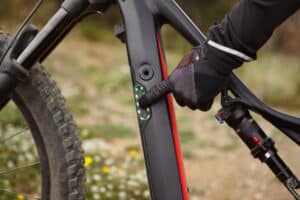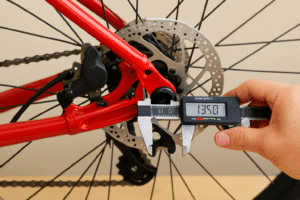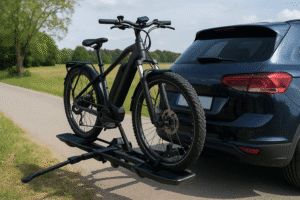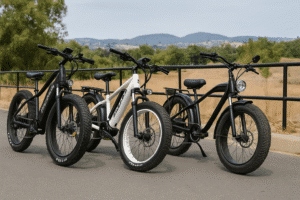Can you put an electric bike on a bike rack without damaging it? The short answer is yes, but only if you use the right kind of rack.
E-bikes are heavier and bulkier than regular bikes, so choosing a rack built to handle that extra weight is key to keeping your ride safe and secure on the road.
Key Summary:
- You can put an electric bike on a bike rack, but only if it’s rated for a higher weight and wider tires.
- Hitch-mounted platform racks are the safest and most stable option for transporting e-bikes.
- Always remove the battery before loading to reduce weight and protect the electronics.
- Avoid roof or trunk racks, as they aren’t built to handle the size and weight of most e-bikes.
Can You Really Put an Electric Bike on a Bike Rack?
Yes, you can put an electric bike on a bike rack, but only if the rack is rated to handle the bike’s extra weight and size. Most e-bikes weigh between 50 and 80 pounds, which is far heavier than a standard bicycle. That means not all regular racks are built to carry them safely.
E-bike-friendly racks are designed with higher weight limits and wider wheel trays to fit fat tires and larger frames.
Many come with ramps that help you roll the bike on instead of lifting it. This is especially helpful for heavier commuter and cargo e-bikes.
It’s also smart to remove your battery before loading your bike. Doing so not only reduces weight but also protects the battery from bumps and heat during long drives.
With the right rack and setup, taking your e-bike on a road trip or outdoor ride is completely doable.
Why Regular Bike Racks Don’t Always Work
Regular bike racks usually can’t hold electric bikes because they aren’t designed for the extra weight or unique frame shapes. A rack built for a 35-pound mountain bike won’t safely carry a 70-pound e-bike with a battery and motor.
Below are the main reasons traditional racks fall short when it comes to e-bikes:
Weight Limits
Most standard bike racks have a weight limit of 30–40 pounds per bike. E-bikes often weigh nearly double that, so using a regular rack can bend the arms or even snap the mount.
E-bike-specific racks usually support 60–100 pounds per bike and are built with stronger steel frames and thicker wheel supports.
Frame and Tire Fit
E-bikes come in many designs, step-through frames, cargo styles, and fat-tire models. Many traditional racks use frame clamps or narrow trays that don’t fit these shapes.
A proper e-bike rack offers adjustable arms and wider tire holders that can accommodate tires up to 5 inches wide.
Read more: Fat tire bike vs mountain bike
Loading and Stability
Lifting a 70-pound bike onto a roof or hanging-style rack is risky for both you and your bike. The weight can throw off your balance, and the rack’s arms may not secure the bike firmly enough.
Platform-style hitch racks solve this by keeping the bike low to the ground and providing even weight distribution across both wheels.
Safety on the Road
A rack not made for e-bikes can sway, loosen, or even fail completely at highway speeds. The extra mass creates more pressure on the mounting points and hitch.
Always check your rack’s weight rating and your car’s hitch capacity before hitting the road.
Best Types of Racks for Electric Bikes
Not all bike racks are built for the weight and size of an e-bike. The best racks are sturdy, stable, and designed to handle heavier loads without shaking or bending.
Here are the main types to consider and what makes each one ideal for electric bikes.
Hitch-Mounted Platform Racks
These are the most reliable and popular racks for e-bikes. They attach to your vehicle’s hitch receiver and keep bikes low to the ground, making loading easier. Platform racks hold the bike by its wheels, providing solid balance and reducing frame stress.
- Weight Capacity: Usually 60–100 lbs per bike.
- Best For: Heavy e-bikes, fat-tire bikes, and long trips.
- Why It Works: They distribute weight evenly, minimize sway, and often support multiple bikes.
If your car has a 2-inch hitch, this is your safest and most stable option. These racks are strong enough to carry heavy e-bikes while keeping them balanced and easy to load.
You can also read our quick comparison of the difference between 2-inch and 1¼-inch e-bike rack mounts.
Racks with Loading Ramps
Lifting a 70-pound e-bike is no joke. Racks with built-in ramps let you roll the bike into position, protecting your back and your bike.
- Best For: Commuter, cargo, and senior riders.
- Tip: Look for foldable or telescoping ramps that store easily when not in use.
These racks are especially handy for heavier mid-drive e-bikes with wide tires and lower step-through frames.
Fat-Tire Compatible Racks
If your e-bike has tires wider than 3 inches, a regular tray won’t fit securely. Fat-tire racks have extra-wide cradles that hold up to 5-inch tires without squeezing or scratching them.
- Best For: Off-road, all-terrain, and beach e-bikes.
RV and Camper-Approved Racks
If you travel with an RV or camper, choose a rack specifically rated for RV use. These racks are reinforced to handle the extra bounce and vibration that comes with long drives.
- Best For: Full-time travelers or those hauling multiple e-bikes.
- Note: Always check that your RV bumper or hitch can safely handle the total rack weight.
You can check out our detailed breakdown of the best bike racks for electric bikes to find one that fits your setup perfectly.
How to Safely Load and Transport an Electric Bike
Loading an e-bike correctly prevents damage and keeps your trip stress-free. Here’s a simple step-by-step process to follow:
- Remove the battery and accessories: Take out the battery, display, or any removable lights before lifting. This lightens the bike and protects sensitive components.
- Prepare the rack: Double-check the hitch connection and tighten all bolts. Make sure wheel trays and clamps are adjusted to fit your bike’s size.
- Use a ramp or helper: Roll your e-bike up using a ramp if your rack includes one. If not, lift with your knees (not your back) or ask for help.
- Secure the wheels and frame: Use wheel straps, frame clamps, or both. Ensure the tires sit fully in the tray and the bike doesn’t rock or tilt.
- Check the hitch and straps: Tug on the bike gently to confirm everything is locked tight. The rack shouldn’t wobble when you shake it.
- Protect electrical components: If rain is expected, cover the motor area and connectors with a waterproof bag or wrap.
- Drive mindfully: Avoid sudden braking or sharp turns. Stop after the first few miles to recheck your straps and connections.
Mistakes to Avoid
Transporting an e-bike seems simple, but a few small oversights can cause big problems. Avoid these common mistakes to keep your trip smooth and safe:
- Using a non-rated rack: Regular racks often can’t support an e-bike’s weight and can fail on the road.
- Leaving the battery attached: It adds extra weight and can overheat or get damaged while driving.
- Ignoring hitch capacity: The combined weight of the rack and bikes must stay below your vehicle’s tongue weight limit.
- Mounting on a roof rack: E-bikes are too heavy to lift safely overhead and can cause roof or frame damage.
- Not checking straps mid-trip: Vibration can loosen fasteners over time. Stop occasionally to tighten and inspect them.
- Skipping rain protection: Water and dust can harm your display, motor, and connectors during transport.
Can You Carry More Than One E-Bike?
Yes, you can carry more than one electric bike if your rack and vehicle hitch are rated for the combined weight. Most heavy-duty hitch racks can hold two e-bikes, but you’ll need to double-check both the rack’s capacity and your vehicle’s tongue weight limit before loading up.
E-bikes can weigh anywhere between 50 and 80 pounds each, meaning two bikes plus the rack can easily reach 180–200 pounds total.
A Class III 2-inch hitch is usually the minimum requirement for that kind of load. Always check your owner’s manual or hitch label for the weight limit.
If you plan to carry multiple e-bikes often, look for racks built specifically for dual e-bike setups. Removing both batteries before loading helps keep things balanced and reduces stress on the rack.
Tips for Long Trips
Taking your e-bike on long drives is easy when you prepare ahead of time. Here are some practical tips to keep your bikes and rack in top shape:
- Inspect connections regularly: Check all straps, bolts, and hitch pins every few hours of driving.
- Keep things clean: Wipe off dirt, bugs, or road salt during stops to protect the paint and electrical parts.
- Secure loose parts: Fasten handlebars, pedals, and mirrors to prevent vibration damage.
- Use a cover in bad weather: A waterproof cover or tarp protects electronics from rain and dust.
- Add reflective straps or lights: Improves visibility at night, especially if the rack blocks your car’s taillights.
- Avoid overloading: Never exceed your hitch’s or rack’s stated weight limit, even by a few pounds.
Final Words
You can absolutely put an electric bike on a rack; you just need the right one for the job.
A sturdy hitch-mounted platform rack is the safest choice, especially for heavier or fat-tire models. Always remove the battery before loading, check the rack’s weight rating, and make sure everything is secure before you hit the road.
Whether you’re heading to a mountain trail or taking a cross-country trip, transporting your e-bike safely protects both your investment and your peace of mind.
The right rack makes loading simple, travel easy, and your adventures limitless.
FAQs
Can any bike rack hold an e-bike?
No. Most regular bike racks aren’t strong enough to hold the extra weight of an electric bike. You need a rack rated for at least 60 pounds per bike, preferably a hitch-mounted platform rack built for e-bikes.
Can you put an e-bike on a car roof?
It’s not recommended. E-bikes are heavy, and lifting them overhead can be unsafe. Roof racks also can’t handle the weight and may damage your car or the bike during transport.
Should I remove the e-bike battery during transport?
Yes. Removing the battery reduces weight and keeps it safe from vibration, heat, or impact while driving. It’s one of the simplest ways to protect your e-bike’s electrical system.
Do I need a special hitch for an e-bike rack?
Usually yes. Most e-bike racks require a 2-inch Class III hitch because it can support more weight and provides better stability. Always check your vehicle’s hitch rating before installation.
Are trunk racks safe for e-bikes?
No. Trunk racks are designed for lightweight bicycles and can’t handle the weight or size of an e-bike. Using one risks damaging both your car and your bike.
Michael Josh is a hands-on e-bike tester and reviewer at BoltBikers, known for putting every model through real-world rides before sharing his thoughts. With a sharp eye for performance, comfort, and build quality, he helps the team choose which bikes are worth featuring. Backed by years of experience in tech and gear reviews, Michael brings trusted, honest insights to help readers find the right e-bike for their needs.








